Dell MTC2, DMC, G7279 User Manual

Dell™ Dimension™ 4600 Series
Service Tag 
CD or DVD headphone connector
CD or DVD volume control dial
floppy drive light*  power light power button
power light power button 
 CD or DVD drive activity light
CD or DVD drive activity light

 CD or DVD eject button
CD or DVD eject button
 floppy drive eject button*
floppy drive eject button*
hard-drive activity light
USB 2.0 connectors (2)
 headphone connector
headphone connector
*On computers with an optional floppy drive.
power connector voltage selection switch serial connector 
integrated video connector** keyboard connector center/LFE connector*
keyboard connector center/LFE connector* line-out connector*
line-out connector*
microphone connector* USB 2.0 connectors (6) 
PCI card slots (3)
parallel connector |
diagnostic lights (4) |
mouse connector |
surround connector* |
line-in connector* |
cover latch |
network adapter connector |
video connector*** |
optional sound card connector |
(see the setup diagram) |
*On computers with integrated sound. **On computers with integrated video.
***On computers with a video card.
Model DMC, MTC2
w w w . d e l l . c o m | s u p p o r t . d e l l . c o m

Notes, Notices, and Cautions
NOTE: A NOTE indicates important information that helps you make better use of your computer.
NOTICE: A NOTICE indicates either potential damage to hardware or loss of data and tells you how to avoid the problem.
 CAUTION: A CAUTION indicates a potential for property damage, personal injury, or death.
CAUTION: A CAUTION indicates a potential for property damage, personal injury, or death.
Abbreviations and Acronyms
For a complete list of abbreviations and acronyms, see the Tell Me How help file. To access help files, see page 21.
If you purchased a Dell™ n Series computer, any references in this document to Microsoft® Windows® operating systems are not applicable.
Information in this document is subject to change without notice. © 2003–2004 Dell Inc. All rights reserved.
Reproduction in any manner whatsoever without the written permission of Dell Inc. is strictly forbidden.
Trademarks used in this text: Dell, the DELL logo, DellNet, Inspiron, Dell Precision, Dimension, OptiPlex, PowerVault, PowerApp, PowerEdge,
PowerConnect, Axim, and Latitude are trademarks of Dell Inc.; Intel, Pentium, and Celeron are registered trademarks of Intel Corporation; Microsoft and Windows are registered trademarks of Microsoft Corporation; EMC is a registered trademark of EMC Corporation.
Other trademarks and trade names may be used in this document to refer to either the entities claiming the marks and names or their products. Dell Inc. disclaims any proprietary interest in trademarks and trade names other than its own.
Model DMC, MTC2
July 2004 |
P/N G7279 |
Rev. A00 |

Contents
Safety Instructions. . . . . . . . . . . . . . . . . . . . . . . . . . . . . |
7 |
Finding Information for Your Computer . . . . . . . . . . . . . . . . . . . |
9 |
1 Setting Up and Using Your Computer
Setting Up a Printer . . . . . . . . . . . . . . . . . . . . . . . . . . . . |
11 |
Printer Cable . . . . . . . . . . . . . . . . . . . . . . . . . . . . . |
11 |
Connecting a Parallel Printer . . . . . . . . . . . . . . . . . . . . . |
11 |
Connecting a USB Printer . . . . . . . . . . . . . . . . . . . . . . . |
12 |
Setting Up a Home and Office Network . . . . . . . . . . . . . . . . . . . |
13 |
Connecting to a Network Adapter . . . . . . . . . . . . . . . . . . . |
13 |
Network Setup Wizard . . . . . . . . . . . . . . . . . . . . . . . . |
14 |
Connecting to the Internet . . . . . . . . . . . . . . . . . . . . . . . . . |
14 |
Setting Up Your Internet Connection . . . . . . . . . . . . . . . . . . |
15 |
Copying CDs and DVDs. . . . . . . . . . . . . . . . . . . . . . . . . . . |
16 |
How to Copy a CD or DVD . . . . . . . . . . . . . . . . . . . . . . . |
16 |
Using Blank CD-Rs and CD-RWs . . . . . . . . . . . . . . . . . . . . |
16 |
Helpful Tips . . . . . . . . . . . . . . . . . . . . . . . . . . . . . . |
17 |
Hyper-Threading. . . . . . . . . . . . . . . . . . . . . . . . . . . . . . |
17 |
Booting to a USB Device . . . . . . . . . . . . . . . . . . . . . . . . . . |
18 |
Turning Off Your Computer . . . . . . . . . . . . . . . . . . . . . . . . . |
18 |
2 Solving Problems
Finding Solutions . . . . . . . . . . . . . . . . . . . . . . . . . . . . . |
19 |
Finding Help Information . . . . . . . . . . . . . . . . . . . . . . . . . . |
21 |
Battery Problems . . . . . . . . . . . . . . . . . . . . . . . . . . . . . |
21 |
Drive Problems . . . . . . . . . . . . . . . . . . . . . . . . . . . . . . |
21 |
Floppy drive problems . . . . . . . . . . . . . . . . . . . . . . . . . |
21 |
CD drive problems. . . . . . . . . . . . . . . . . . . . . . . . . . . |
22 |
Contents 3

Problems writing to a CD-RW drive. . . . . . . . . . . . . . . . . . . |
23 |
DVD drive problems . . . . . . . . . . . . . . . . . . . . . . . . . . |
23 |
Hard drive problems. . . . . . . . . . . . . . . . . . . . . . . . . . |
24 |
E-Mail, Modem, and Internet Problems . . . . . . . . . . . . . . . . . . . |
24 |
Error Messages . . . . . . . . . . . . . . . . . . . . . . . . . . . . . . |
25 |
General Problems . . . . . . . . . . . . . . . . . . . . . . . . . . . . . |
26 |
The computer stops responding . . . . . . . . . . . . . . . . . . . . |
26 |
A program stops responding . . . . . . . . . . . . . . . . . . . . . . |
27 |
A program crashes repeatedly . . . . . . . . . . . . . . . . . . . . . |
27 |
A program is designed for an earlier Microsoft® Windows® |
|
operating system . . . . . . . . . . . . . . . . . . . . . . . . . . . |
27 |
A solid blue screen appears . . . . . . . . . . . . . . . . . . . . . . |
27 |
Other software problems . . . . . . . . . . . . . . . . . . . . . . . |
27 |
Other technical problems . . . . . . . . . . . . . . . . . . . . . . . |
28 |
General hardware problems . . . . . . . . . . . . . . . . . . . . . . |
28 |
IEEE 1394 Device Problems. . . . . . . . . . . . . . . . . . . . . . . . . |
29 |
Keyboard Problems . . . . . . . . . . . . . . . . . . . . . . . . . . . . |
30 |
Mouse Problems. . . . . . . . . . . . . . . . . . . . . . . . . . . . . . |
30 |
Network Problems. . . . . . . . . . . . . . . . . . . . . . . . . . . . . |
31 |
Power Problems . . . . . . . . . . . . . . . . . . . . . . . . . . . . . . |
32 |
Printer Problems. . . . . . . . . . . . . . . . . . . . . . . . . . . . . . |
33 |
Scanner Problems . . . . . . . . . . . . . . . . . . . . . . . . . . . . . |
34 |
Sound and Speaker Problems . . . . . . . . . . . . . . . . . . . . . . . |
35 |
No sound from speakers. . . . . . . . . . . . . . . . . . . . . . . . |
35 |
No sound from headphones . . . . . . . . . . . . . . . . . . . . . . |
36 |
Video and Monitor Problems . . . . . . . . . . . . . . . . . . . . . . . . |
36 |
If the screen is blank . . . . . . . . . . . . . . . . . . . . . . . . . |
36 |
If the screen is difficult to read. . . . . . . . . . . . . . . . . . . . . |
37 |
4 Contents

3 Advanced Troubleshooting |
|
Diagnostic Lights . . . . . . . . . . . . . . . . . . . . . . . . . . . . . |
39 |
Dell Diagnostics . . . . . . . . . . . . . . . . . . . . . . . . . . . . . . |
43 |
Starting the Dell Diagnostics. . . . . . . . . . . . . . . . . . . . . . |
43 |
Dell Diagnostics Main Menu . . . . . . . . . . . . . . . . . . . . . . |
44 |
Drivers . . . . . . . . . . . . . . . . . . . . . . . . . . . . . . . . . . |
45 |
What Is a Driver? . . . . . . . . . . . . . . . . . . . . . . . . . . . |
45 |
Identifying Drivers. . . . . . . . . . . . . . . . . . . . . . . . . . . |
45 |
Reinstalling Drivers . . . . . . . . . . . . . . . . . . . . . . . . . . |
45 |
Restoring Your Operating System . . . . . . . . . . . . . . . . . . . . . . |
46 |
Using Microsoft Windows XP System Restore . . . . . . . . . . . . . |
47 |
Using Dell PC Restore by Symantec . . . . . . . . . . . . . . . . . . |
48 |
Resolving Software and Hardware Incompatibilities . . . . . . . . . . . . |
49 |
4 Adding Parts
Front and Back View of the Computer. . . . . . . . . . . . . . . . . . . . |
51 |
Front View . . . . . . . . . . . . . . . . . . . . . . . . . . . . . . |
51 |
Back View . . . . . . . . . . . . . . . . . . . . . . . . . . . . . . |
53 |
Removing the Computer Cover . . . . . . . . . . . . . . . . . . . . . . . |
55 |
Looking Inside Your Computer . . . . . . . . . . . . . . . . . . . . . . . |
57 |
System Board . . . . . . . . . . . . . . . . . . . . . . . . . . . . . |
58 |
Adding Cards . . . . . . . . . . . . . . . . . . . . . . . . . . . . . . . |
59 |
Adding or Replacing the AGP Card . . . . . . . . . . . . . . . . . . . . . |
61 |
Removing an AGP Card . . . . . . . . . . . . . . . . . . . . . . . . |
62 |
Installing an AGP Card . . . . . . . . . . . . . . . . . . . . . . . . |
62 |
Adding or Replacing a Second Hard Drive . . . . . . . . . . . . . . . . . |
63 |
Adding a Floppy Drive . . . . . . . . . . . . . . . . . . . . . . . . . . . |
66 |
Adding a Second CD or DVD Drive . . . . . . . . . . . . . . . . . . . . . |
70 |
Contents 5

Adding Memory . . . . . . . . . . . . . . . . . . . . . . . . . . . . . . |
75 |
DDR Memory Overview . . . . . . . . . . . . . . . . . . . . . . . . |
75 |
Memory Installation Guidelines . . . . . . . . . . . . . . . . . . . . |
75 |
Installing Memory . . . . . . . . . . . . . . . . . . . . . . . . . . . |
76 |
Replacing the Computer Cover . . . . . . . . . . . . . . . . . . . . . . . |
78 |
5 |
Appendix |
|
|
Specifications . . . . . . . . . . . . . . . . . . . . . . . . . . . . . . . |
79 |
|
System Setup . . . . . . . . . . . . . . . . . . . . . . . . . . . . . . . |
82 |
|
Overview . . . . . . . . . . . . . . . . . . . . . . . . . . . . . . . |
82 |
|
Viewing Settings . . . . . . . . . . . . . . . . . . . . . . . . . . . |
83 |
|
Boot Sequence . . . . . . . . . . . . . . . . . . . . . . . . . . . . |
84 |
|
Clearing Forgotten Passwords . . . . . . . . . . . . . . . . . . . . . . . |
85 |
|
Replacing the Battery . . . . . . . . . . . . . . . . . . . . . . . . . . . |
86 |
|
Dell Technical Support Policy (U.S. Only) . . . . . . . . . . . . . . . . . . |
88 |
|
Definition of "Dell-Installed" Software and Peripherals . . . . . . . . . |
88 |
|
Definition of "Third-Party" Software and Peripherals . . . . . . . . . . |
88 |
|
FCC Notices (U.S. Only) . . . . . . . . . . . . . . . . . . . . . . . . . . |
88 |
|
Class A . . . . . . . . . . . . . . . . . . . . . . . . . . . . . . . . |
89 |
|
Class B . . . . . . . . . . . . . . . . . . . . . . . . . . . . . . . . |
89 |
|
FCC Identification Information . . . . . . . . . . . . . . . . . . . . . |
90 |
|
Contacting Dell . . . . . . . . . . . . . . . . . . . . . . . . . . . . . . |
90 |
Index . . . . . . . . . . . . . . . . . . . . . . . . . . . . . . . . . . . |
107 |
|
6 Contents
Safety Instructions
See your Product Information Guide for safety instructions.
Safety Instructions |
|
7 |
|

w w w . d e l l . c o m | s u p p o r t . d e l l . c o m
Instructions Safety 8

Finding Information for Your Computer
What are you looking for? |
Find It Here |
|
|
• How to set up my computer |
S e t u p D i a g r a m |
• Tips on using the Microsoft® |
Te l l M e H o w H e l p F i l e |
|
Windows® operating system |
1 |
Click the Start button and click Help and Support. |
• How to clean my computer |
2 |
Click User and system guides and click User’s guides. |
• How to use my mouse and |
3 |
Click Tell Me How. |
keyboard
• Express Service Code and Service Tag |
E x p r e s s S e r v i c e C o d e a n d P r o d u c t Ke y L a b e l |
• Microsoft Windows License Label |
These labels are located on your |
|
computer. |
|
|
Finding Information for Your Computer |
|
9 |
|

w w w . d e l l . c o m | s u p p o r t . d e l l . c o m
What are you looking for? |
Find It Here |
|
|
|
|
• Latest drivers for my computer |
D e l l S u p p o r t We b s i t e — support.dell.com |
|
• Answers to technical service and |
The Dell Support website provides several online tools, including: |
|
support questions |
• Solutions — Troubleshooting hints and tips, articles from technicians, |
|
• Online discussions with other users and |
||
and online courses |
||
technical support |
• Community Forum — Online discussion with other Dell customers |
|
• Documentation for my computer |
||
• Upgrades — Upgrade information for components, such as memory, |
||
|
||
|
the hard drive, and the operating system |
|
|
• Customer Care — Contact information, order status, warranty, and |
|
|
repair information |
|
|
• Downloads — Drivers, patches, and software updates |
|
|
• Reference — Computer documentation, product specifications, and |
|
|
white papers |
|
|
|
|
• How to use Windows XP |
W i n d o w s X P H e l p a n d S u p p o r t C e n t e r |
|
• Documentation for my computer |
1 Click the Start button and click Help and Support. |
|
• Documentation for devices |
2 Type a word or phrase that describes your problem and click the arrow |
|
(such as a modem) |
icon. |
|
|
3 Click the topic that describes your problem. |
|
|
4 Follow the instructions on the screen. |
|
|
|
10 Finding Information for Your Computer

Setting Up and Using Your Computer
Setting Up a Printer
NOTICE: Complete the operating system setup before you connect a printer to the computer.
See the documentation that came with the printer for setup information, including how to:
•Obtain and install updated drivers.
•Connect the printer to the computer.
•Load paper and install the toner or ink cartridge.
•Contact the printer manufacturer for technical assistance.
Printer Cable
Your printer connects to your computer with either a USB cable or a parallel cable. Your printer may not come with a printer cable, so if you purchase a cable separately, ensure that it is compatible with your printer. If you purchased a printer cable at the same time you purchased your computer, the cable may arrive in the computer box.
Connecting a Parallel Printer
1Complete the operating system setup, if you have not already done so.
2Shut down the computer through the Start menu (see page 18).
NOTICE: For best results, use a 3-m (10-ft) or shorter parallel cable.
3Attach the parallel printer cable to the parallel connector on the computer and tighten the two screws. Attach the cable to the connector on the printer and snap the two clips into the two notches.
Setting Up and Using Your Computer |
|
11 |
|
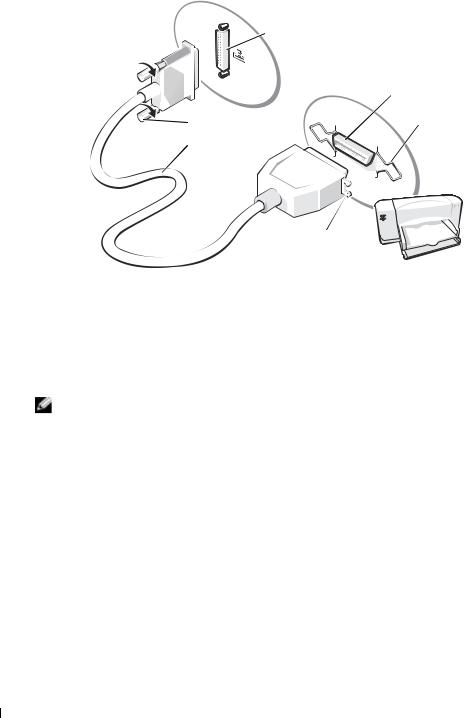
w w w . d e l l . c o m | s u p p o r t . d e l l . c o m
 parallel connector on computer
parallel connector on computer
|
connector on printer |
screws (2) |
clips (2) |
parallel printer |
|
cable |
|
notches (2) 
4Turn on the printer and then turn on the computer. If the Add New Hardware Wizard window appears, click Cancel.
5Install the printer driver if necessary. See the documentation that came with your printer.
Connecting a USB Printer
NOTE: You can connect USB devices while the computer is turned on.
1Complete the operating system setup if you have not already done so.
2Install the printer driver if necessary. See the documentation that came with your printer.
3Attach the USB printer cable to the USB connectors on the computer and the printer. The USB connectors fit only one way.
12 Setting Up and Using Your Computer
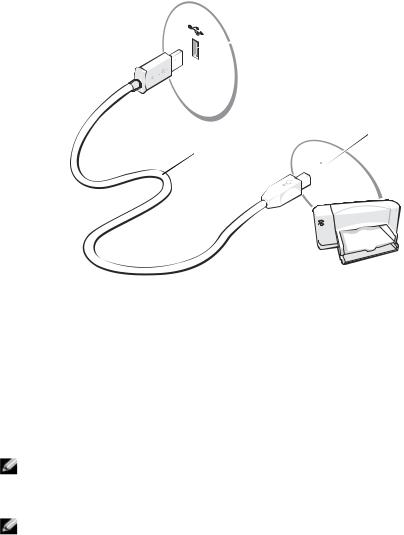

 USB connector on computer
USB connector on computer
 USB connector USB printer on printer cable
USB connector USB printer on printer cable 
Setting Up a Home and Office Network
Connecting to a Network Adapter
Before you connect your computer to a network, the computer must have a network adapter installed and a network cable connected to it.
To connect a network cable:
1 Connect the network cable to the network adapter connector on the back of your computer.
NOTE: Insert the cable until it clicks into place, and then gently pull it to ensure that it is secure.
2Connect the other end of the network cable to a network connection device, such as a network wall jack.
NOTE: Do not use a network cable with a telephone wall jack.
Setting Up and Using Your Computer |
|
13 |
|

w w w . d e l l . c o m | s u p p o r t . d e l l . c o m
network adapter connector on computer
network wall jack
 network cable
network cable
Network Setup Wizard
The Microsoft® Windows® XP operating system provides a Network Setup Wizard to guide you through the process of sharing files, printers, or an Internet connection between computers in a home or small office.
1 Click the Start button, point to All Programs→ Accessories→ Communications, and then click Network Setup Wizard.
2On the welcome screen, click Next.
3Click Checklist for creating a network.
NOTE: Selecting the connection method This computer connects directly to the Internet enables the integrated firewall provided with Windows XP.
4Complete the checklist and required preparations, and return to the Network Setup Wizard.
5Follow the instructions on the screen.
Connecting to the Internet
NOTE: ISPs and ISP offerings vary by country.
To connect to the Internet, you need a modem or network connection and an Internet service provider (ISP), such as AOL or MSN. Your ISP will offer one or more of the following Internet connection options:
•Dial-up connections that provide Internet access through a phone line. Dial-up connections are considerably slower than DSL and cable modem connections.
•DSL connections that provide high-speed Internet access through your existing phone line. With a DSL connection, you can access the Internet and use your phone on the same line simultaneously.
14 Setting Up and Using Your Computer

•Cable modem connections that provide high-speed Internet access through your local cable TV line.
If you are using a dial-up connection, connect a telephone line to the modem connector on your computer and to the telephone wall jack before you set up your Internet connection. If you are using a DSL or cable modem connection, contact your ISP for setup instructions.
Setting Up Your Internet Connection
To set up an AOL or MSN connection:
1Save and close any open files, and exit any open programs.
2Double-click the MSN Explorer or AOL icon on the Windows® desktop.
3Follow the instructions on the screen to complete the setup.
If you do not have an MSN Explorer or AOL icon on your desktop or if you want to set up an Internet connection with a different ISP:
1Save and close any open files, and exit any open programs.
2Click the Start button and click Internet Explorer. The New Connection Wizard appears.
3Click Connect to the Internet.
4In the next window, click the appropriate option:
•If you do not have an ISP and want to select one, click Choose from a list of Internet service providers (ISPs).
•If you have already obtained setup information from your ISP but you did not receive a setup CD, click Set up my connection manually.
•If you have a CD, click Use the CD I got from an ISP.
5Click Next.
If you selected Set up my connection manually, continue to step 6. Otherwise, follow the instructions on the screen to complete the setup.
NOTE: If you do not know which type of connection to select, contact your ISP.
6Click the appropriate option under How do you want to connect to the Internet?, and then click Next.
7Use the setup information provided by your ISP to complete the setup.
If you cannot connect to the Internet but have successfully connected in the past, the ISP might have a service outage. Contact your ISP to check the service status, or try connecting again later.
Setting Up and Using Your Computer |
|
15 |
|

w w w . d e l l . c o m | s u p p o r t . d e l l . c o m
Copying CDs and DVDs
NOTE: Ensure that you follow all copyright laws when you create CDs.
This section applies only to computers that have a CD-R, CD-RW, DVD+RW, DVD+R, or DVD/CD-RW combo drive.
The following instructions show how to make an exact copy of a CD or DVD. You can also use Sonic RecordNow for other purposes, including creating CDs from audio files on your computer and creating MP3 CDs. For instructions, see the Sonic RecordNow documentation that came with your computer. Open Sonic RecordNow, click the question mark icon in the upper-right corner of the window, and click RecordNow Help or RecordNow Tutorial.
How to Copy a CD or DVD
NOTE: If you have a DVD/CD-RW combo drive and you experience recording problems, check for available software patches at the Sonic support website at support.sonic.com.
NOTE: Most commercial DVDs have copyright protection and cannot be copied using Sonic RecordNow.
1 Click the Start button, point to All Programs→ Sonic→ RecordNow!→ RecordNow!.
2Click either the audio tab or the data tab, depending on the kind of CD you are planning to copy.
3Click Exact Copy.
4To copy the CD or DVD:
•If you have one CD or DVD drive, ensure that the settings are correct and click Copy. The computer reads your source CD or DVD and copies it to a temporary folder on your computer hard drive.
When prompted, insert a blank CD or DVD into the CD or DVD drive and click OK.
•If you have two CD or DVD drives, select the drive into which you have inserted your source CD or DVD and click Copy. The computer copies the data on the CD or DVD to the blank CD or DVD.
Once you have finished copying the source CD or DVD, the CD or DVD that you have created automatically ejects.
Using Blank CD-Rs and CD-RWs
Your CD-RW drive can write to two different types of recording media—CD-Rs and CD-RWs. Use blank CD-Rs to record music or permanently store data files. After creating a CD-R, you cannot write to that CD-R again without changing your method of recording (see the Sonic documentation for more information). Use blank CD-RWs to write to CDs or to erase, rewrite, or update data on CDs.
16 Setting Up and Using Your Computer
Helpful Tips
•Use Microsoft® Windows® Explorer to drag and drop files to a CD-R or CD-RW only after you start Sonic RecordNow and open a RecordNow project.
•You must use CD-Rs to burn music CDs that you want to play in regular stereos. CD-RWs do not play in most home or car stereos.
•You cannot create audio DVDs with Sonic RecordNow.
•Music MP3 files can be played only on MP3 players or on computers that have MP3 software installed.
•Do not burn a blank CD-R or CD-RW to its maximum capacity; for example, do not copy a 650-MB file to a 650-MB blank CD. The CD-RW drive needs 1 or 2 MB of the blank CD to finalize the recording.
•Use a blank CD-RW to practice CD recording until you are familiar with CD recording techniques. If you make a mistake, you can erase the data on the CD-RW and try again. You can also use blank CD-RWs to test music file projects before you record the project permanently to a blank CD-R.
•See the Sonic support website at support.sonic.com for additional information.
Hyper-Threading
Hyper-Threading is an Intel® technology that can enhance overall computer performance by allowing one physical microprocessor to function as two logical microprocessors, capable of performing certain tasks simultaneously. It is recommended that you use the Microsoft® Windows® XP operating system because Windows XP is optimized to take advantage of HyperThreading technology. While many programs can benefit from Hyper-Threading, some programs have not been optimized for Hyper-Threading and may require an update from the software manufacturer. Contact the software manufacturer for updates and information about using HyperThreading with your software.
To determine if your computer is using Hyper-Threading technology:
1Click the Start button, right-click My Computer, and then click Properties.
2Click Hardware and click Device Manager.
3In the Device Manager window, click the plus (+) sign next to the processor type. If HyperThreading is enabled, the processor is listed twice.
You can enable or disable Hyper-Threading through system setup. For more information on HyperThreading, search the Knowledge Base on the Dell Support website at support.dell.com.
Setting Up and Using Your Computer |
|
17 |
|

w w w . d e l l . c o m | s u p p o r t . d e l l . c o m
Booting to a USB Device
NOTE: To boot to a USB device, the device must be bootable. To make sure your device is bootable, check the device documentation.
To restart your computer to a USB device such as a floppy drive, memory key, or CD-RW drive:
1Connect the USB device to a USB connector..
2Shut down (see page 18) and restart the computer.
3Turn on the computer. When the DELL™ logo appears, press <F12> immediately.
If you wait too long and the Microsoft® Windows® logo appears, continue to wait until you see the Windows desktop. Then shut down your computer through the Start menu and try again.
NOTE: This procedure changes the boot sequence for one time only. On the next start-up, the computer boots according to the devices specified in system setup.
4When the boot device list appears, highlight USB Flash Device and press <Enter>. The computer restarts to the connected USB device.
Turning Off Your Computer
NOTICE: To avoid losing data, turn off your computer by performing a Microsoft® Windows® operating system shutdown, as described next, rather than by pressing the power button.
1Save and close any open files, exit any open programs, click the Start button, and then click
Turn Off Computer.
2In the Turn off computer window, click Turn off.
The computer turns off after the shutdown process finishes.
18 Setting Up and Using Your Computer
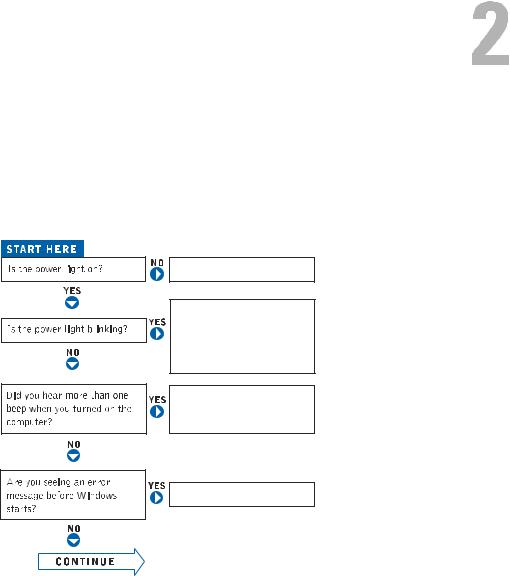
Solving Problems
Finding Solutions
Sometimes it’s difficult to figure out where to go for answers. Use this chart to help you quickly find the answers to your questions.
See page 32.
Press a key or move the mouse. See the Tell Me How help file for information on standby mode. For more information, see page 32.
Get technical assistance from
Dell. See page 88.
See page 25.
Solving Problems |
|
19 |
|
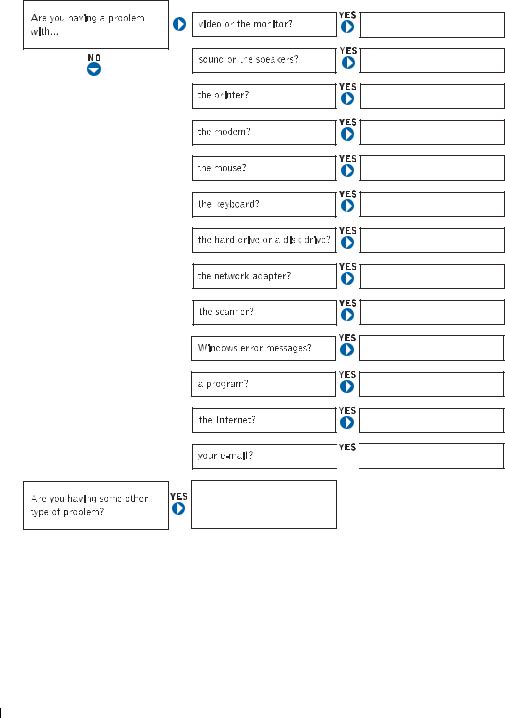
w w w . d e l l . c o m | s u p p o r t . d e l l . c o m
See page 36.
See page 35.
See page 33.
See page 24.
See page 30.
See page 30.
See page 21.
See page 31.
See page 34.
See page 25.
See page 26.
See page 24.


 See page 24.
See page 24.
See page 26.
20 Solving Problems
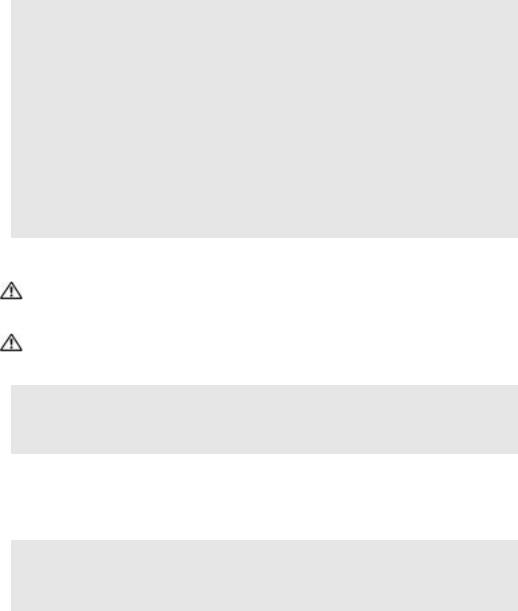
Finding Help Information
TO ACCESS THE TELL ME HOW HELP FILE —
1 Click the Start button and click Help and Support.
2 Click User and system guides and click User’s guides. 3 Click Tell Me How.
TO ACCESS WINDOWS HELP —
1 Click the Start button and click Help and Support.
2 Type a word or phrase that describes your problem and click the arrow icon. 3 Click the topic that describes your problem.
4 Follow the instructions shown on the screen.
TO LOCATE ADDITIONAL INFORMATION FOR YOUR COMPUTER — See page 9.
Battery Problems
CAUTION: There is a danger of a new battery exploding if it is incorrectly installed. Replace the battery only with the same or equivalent type recommended by the manufacturer. Discard used batteries according to the manufacturer's instructions.
CAUTION: Before you begin any of the procedures in this section, follow the safety instructions located in the Product Information Guide.
REPLACE THE BATTERY — If you have to repeatedly reset time and date information after turning on the computer, or if an incorrect time or date displays during start-up, replace the battery (see page 86). If the battery still does not work properly, contact Dell (see page 90).
Drive Problems
Floppy drive problems
ENSURE THAT WINDOWS® RECOGNIZES THE DRIVE — Click the Start button and click My Computer. If the floppy drive is not listed, perform a full scan with your antivirus software to check for and remove viruses. Viruses can sometimes prevent Windows from recognizing the drive.
Solving Problems |
|
21 |
|
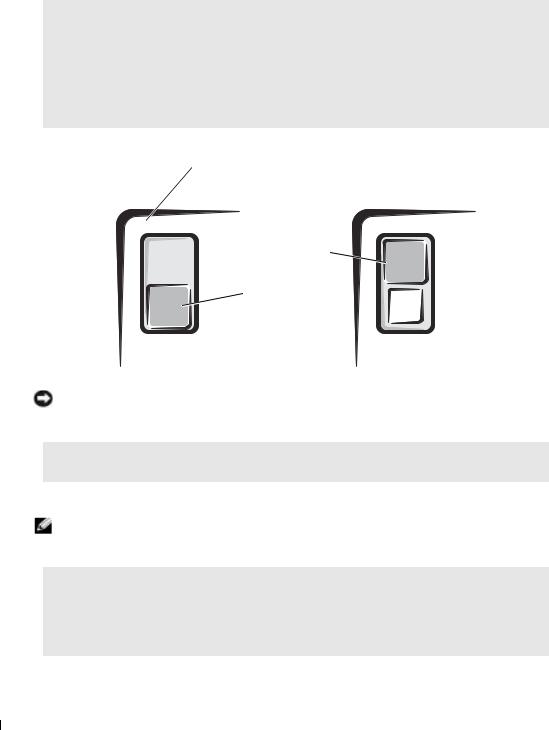
w w w . d e l l . c o m | s u p p o r t . d e l l . c o m
TEST THE DRIVE —
•Insert another disk to eliminate the possibility that the original floppy disk is defective.
•Insert a bootable floppy disk and reboot the computer.
ENSURE THAT THE DISK IS NOT FULL OR WRITE-PROTECTED — Ensure that the disk has available space and that it is not write-protected (locked). See the following figure.
back of floppy disk
write-protected
not writeprotected
NOTICE: Do not attempt to clean drive heads with a swab. You may accidentally misalign the heads, which can render the drive inoperable.
CLEAN THE DRIVE — Use a commercially available cleaning kit.
CD drive problems
NOTE: High-speed CD drive vibration is normal and may cause noise, which does not indicate a defect in the drive or the CD.
ADJUST THE WINDOWS VOLUME CONTROL — Click the speaker icon in the lower-right corner of your screen.
•Ensure that the volume is turned up by clicking the slidebar and dragging it up.
•Ensure that the sound is not muted by clicking any boxes that are checked.
22 Solving Problems

TEST THE DRIVE WITH ANOTHER CD — Insert another CD to eliminate the possibility that the original CD is defective.
CHECK THE SPEAKERS AND SUBWOOFER — See "Sound and Speaker Problems" on page 35.
ENSURE THAT WINDOWS RECOGNIZES THE DRIVE — Click the Start button and click My Computer. If the CD drive is not listed, perform a full scan with your antivirus software to check for and remove viruses. Viruses can sometimes prevent Windows from recognizing the drive.
CLEAN THE DISC — See the Tell Me How help file for instructions on cleaning your CDs. To access help files, see page 21.
Problems writing to a CD-RW drive
CLOSE OTHER PROGRAMS — The CD-RW drive must receive a steady stream of data when writing. If the stream is interrupted, an error occurs. Try closing all programs before writing to the CD-RW.
TURN OFF STANDBY MODE IN WINDOWS BEFORE WRITING TO A CD-RW DISC — For information on power conservation modes, see the Tell Me How help file or search for the keyword standby in Windows Help. To access help files, see page 21.
DVD drive problems
NOTE: Because of different regions worldwide and different disc formats, not all DVD titles work in all DVD drives.
TEST THE DRIVE WITH ANOTHER DVD — Insert another DVD to eliminate the possibility that the original DVD is defective.
ENSURE THAT WINDOWS RECOGNIZES THE DRIVE — Click the Start button and click My Computer. If the DVD drive is not listed, perform a full scan with your antivirus software to check for and remove viruses. Viruses can sometimes prevent Windows from recognizing the drive.
CLEAN THE DISC — See the Tell Me How help file for instructions on cleaning your DVDs. To access help files, see page 21.
CHECK FOR INTERRUPT REQUEST CONFLICTS — See page 49.
Solving Problems |
|
23 |
|

w w w . d e l l . c o m | s u p p o r t . d e l l . c o m
Hard drive problems
RUN CHECK DISK —
1 Click the Start button and click My Computer.
2 Right-click the drive letter (local disk) that you want to scan for errors, and then click Properties. 3 Click the Tools tab.
4 Under Error-checking, click Check Now. 5 Click Start.
E-Mail, Modem, and Internet Problems
NOTE: Connect the modem to an analog telephone jack only. The modem does not operate while it is connected to a digital telephone network.
CHECK THE TELEPHONE LINE CONNECTION — Verify that the telephone line is connected to the jack on the modem. (The jack has either a green label or a connector-shaped icon next to it.) Ensure that you hear a click when you insert the telephone line connector into the modem.
CHECK THE TELEPHONE JACK — Disconnect the telephone line from the modem and connect it to a telephone. Listen for a dial tone.
CONNECT THE MODEM DIRECTLY TO THE TELEPHONE WALL JACK — If you have other telephone devices sharing the line, such as an answering machine, fax machine, surge protector, or line splitter, then bypass them and use the telephone to connect the modem directly to the telephone wall jack.
USE A DIFFERENT TELEPHONE LINE — If you are using a line that is 3 m (10 ft) or more in length, try a shorter one.
RUN THE MODEM HELPER DIAGNOSTICS — Click the Start button, point to All Programs, and then click Modem Helper. Follow the instructions on the screen to identify and resolve modem problems. (Modem Helper is not available on all computers.)
24 Solving Problems

VERIFY THAT THE MODEM IS COMMUNICATING WITH WINDOWS® —
1 Click the Start button and click Control Panel.
2 Click Printers and Other Hardware.
3 Click Phone and Modem Options.
4 Click the Modems tab.
5 Click the COM port for your modem.
6 Click Properties, click the Diagnostics tab, and then click Query Modem to verify that the modem is communicating with Windows.
If all commands receive responses, the modem is operating properly.
TURN OFF CALL WAITING (CATCH-PHONE) — See your telephone directory for instructions on deactivating this feature. Then adjust the dial-up networking connection properties.
1 Click the Start button and click Control Panel.
2 Click Printers and Other Hardware, and then click Phone and Modem Options.
3 Click your connection type to highlight it. 4 Click the Dialing Rules tab and click Edit.
5 Click the To Disable Call Waiting box to place a checkmark in it.
6 Select the disable code from the drop-down menu (for example, *70). 7 Click Apply and click OK.
ENSURE THAT YOU ARE CONNECTED TO THE INTERNET — With the Outlook Express e-mail program open, click File. If Work Offline has a checkmark next to it, click the checkmark to remove it and connect to the Internet.
ENSURE THAT YOU HAVE SUBSCRIBED TO AN INTERNET SERVICE PROVIDER — Contact an Internet service provider to subscribe.
CONTACT YOUR INTERNET SERVICE PROVIDER — Contact your Internet service provider for assistance.
Error Messages
If the message is not listed, see the documentation for the operating system or the program that was running when the message appeared.
A FILENAME CANNOT CONTAIN ANY OF THE FOLLOWING CHARACTERS: \ / : * ? “ < > | — Do not use these characters in filenames.
Solving Problems |
|
25 |
|

w w w . d e l l . c o m | s u p p o r t . d e l l . c o m
A REQUIRED .DLL FILE WAS NOT FOUND — The program that you are trying to open is missing an essential file. To remove and then reinstall the program:
1 Click the Start button and click Control Panel.
2 Click Add or Remove Programs.
3 Select the program you want to remove.
4 Click the Change or Remove Program icon.
5 See the program documentation for installation instructions.
— The operating system is trying to boot to a nonbootable floppy disk or CD. Insert a bootable floppy disk or CD.
NON-SYSTEM DISK ERROR — A floppy disk is in the floppy drive. Remove the floppy disk and restart the computer.
NOT ENOUGH MEMORY OR RESOURCES. CLOSE SOME PROGRAMS AND TRY AGAIN — You have too many programs open. Close all windows and open the program that you want to use. In some cases, you might have to restart your computer to restore computer resources. If so, run the program that you want to use first.
OPERATING SYSTEM NOT FOUND — Contact Dell (see page 90).
THE FILE BEING COPIED IS TOO LARGE FOR THE DESTINATION DRIVE — The file that you are trying to copy is too large to fit on the disk. Try copying the file to a blank disk or using a larger-capacity disk.
x:\ IS NOT ACCESSIBLE. THE DEVICE IS NOT READY — The floppy drive cannot read the disk. Insert a floppy disk into the drive and try again.
General Problems
The computer stops responding
TURN THE COMPUTER OFF — If your computer locks up and you are unable to get a response by pressing a key on your keyboard or moving your mouse, press and hold the power button for at least 8 to 10 seconds until the computer turns off. Then press the power button again to turn on the computer. You might lose data if you are unable to perform an operating system shutdown.
26 Solving Problems

A program stops responding
END THE PROGRAM —
1 Press <Ctrl><Shift><Esc> simultaneously.
2 Click Applications.
3 Click the program that is no longer responding.
4 Click End Task.
A program crashes repeatedly
NOTE: Software usually includes installation instructions in its documentation or on a floppy disk or CD.
CHECK THE SOFTWARE DOCUMENTATION — Many software manufacturers maintain websites with information that may help you solve the problem. Ensure that you properly installed and configured the program. If necessary, uninstall and then reinstall the program.
A program is designed for an earlier Microsoft® Windows® operating system
RUN THE PROGRAM COMPATIBILITY WIZARD —
Windows XP provides a Program Compatibility Wizard that configures a program so it runs in an environment similar to non-Windows XP operating system environments.
1 Click the Start button, point to All Programs→ Accessories, and then click Program Compatibility Wizard.
2 In the welcome screen, click Next.
3 Follow the instructions on the screen.
A solid blue screen appears
TURN THE COMPUTER OFF — If the computer does not respond to a keystroke or a proper shutdown, press the power button for at least 8 to 10 seconds until the computer turns off. Press the power button again to restart the computer. The chkdsk program automatically runs during the start-up process. Follow the instructions on the screen.
Other software problems
CHECK THE SOFTWARE DOCUMENTATION OR CONTACT THE SOFTWARE MANUFACTURER FOR TROUBLESHOOTING INFORMATION
Solving Problems |
|
27 |
|

w w w . d e l l . c o m | s u p p o r t . d e l l . c o m
BACK UP YOUR FILES IMMEDIATELY — If your computer has a CD-RW drive or a zip drive installed, see the drive’s documentation for instructions.
ENSURE THAT YOU HAVE NOT MADE AN ERROR WHILE ENTERING DATA — See the program documentation to ensure that the values or characters you are entering are valid.
CHECK FOR VIRUSES — Use a virus-scanning program to check the hard drive, floppy disks, or CDs.
RESTART THE COMPUTER — Save and close any open files, exit any open programs, and then shut down your computer through the Start menu instead of by pressing the power button. Otherwise, you may lose data.
CHECK FOR COMPATIBILITY —
•Ensure that the program is compatible with the operating system installed on your computer and that your computer meets the minimum hardware requirements needed to run the software. See the software documentation for information.
•If necessary, uninstall and then reinstall the program.
ENSURE THAT YOU PROPERLY INSTALLED AND CONFIGURED THE PROGRAM — See the software documentation for information. If necessary, uninstall and then reinstall the program.
Other technical problems
GO TO THE DELL SUPPORT WEBSITE — Go to support.dell.com for help with general usage, installation, and troubleshooting questions.The support website offers several different tools to help you, such as Dell Forum—a chat room where you can communicate with other Dell customers about their computers and gain access to technical support through e-mail. See "Dell Technical Support Policy (U.S. Only)" on page 88 for a description of the hardware and software support provided by Dell.
CALL DELL — If you cannot solve your problem using the Dell Support website or e-mail service, call Dell for technical assistance (see page 90). See "Dell Technical Support Policy (U.S. Only)" on page 88 for a description of the hardware and software support provided by Dell.
General hardware problems
If your computer exhibits one or more of the following symptoms, a device conflict may exist:
•Your computer locks up, particularly while using a specific device.
•A recently added device does not work.
•A sound card emits noise or demonstrates other problems.
28 Solving Problems

•Unintelligible characters print from the printer.
•The mouse pointer does not move or "stutters" when it moves.
•Messages appear stating that the computer is not operating at maximum performance.
•Errors occur and programs crash for no apparent reason.
•Nothing displays on the monitor.
REMOVE ANY RECENTLY ADDED HARDWARE TO SEE IF IT RESOLVES THE CONFLICT — If removing the hardware resolves the conflict, see the hardware documentation for configuration and troubleshooting instructions. If the problem persists, contact the hardware manufacturer for technical assistance.
CHECK YOUR OPERATING SYSTEM DOCUMENTATION FOR ADDITIONAL TROUBLESHOOTING INFORMATION
CHECK FOR INTERRUPT REQUEST CONFLICTS — See page 49.
IEEE 1394 Device Problems
NOTE: Check Windows Explorer to see if your device is listed as a drive.
CHECK THE IEEE 1394 DEVICE — Ensure that the IEEE 1394 device is properly inserted into the connector.
ENSURE THAT THE IEEE 1394 DEVICE IS RECOGNIZED BY WINDOWS® —
1 Click the Start button.
2Click Control Panel.
3Click Printers and Other Hardware.
If your IEEE 1394 device is listed, Windows recognizes the device.
IF YOU HAVE PROBLEMS WITH A DELL-PROVIDED IEEE 1394 DEVICE — Contact Dell (see page 90).
IF YOU HAVE PROBLEMS WITH AN IEEE 1394 DEVICE NOT PROVIDED BY DELL — Contact the IEEE 1394 device manufacturer.
Solving Problems |
|
29 |
|

w w w . d e l l . c o m | s u p p o r t . d e l l . c o m
Keyboard Problems
RESTART THE COMPUTER —
•If the mouse is functioning, shut down the computer through the Start menu (see page 13). After the computer shuts down, press the power button to restart the computer.
•If the computer does not respond to a keystroke or the mouse, press the power button for at least 8 to 10 seconds until the computer turns off. Press the power button again to restart the computer.
CHECK THE KEYBOARD CABLE —
•Ensure that the keyboard cable is firmly connected to the computer.
•Shut down the computer (see page 13), reconnect the keyboard cable as shown on the setup diagram for your computer, and then restart the computer.
•Check the cable connector for bent or broken pins and for damaged or frayed cables. Straighten bent pins.
•Remove keyboard extension cables and connect the keyboard directly to the computer.
TEST THE KEYBOARD — Connect a properly working keyboard to the computer, and try using the keyboard. If the new keyboard works, the original keyboard is faulty.
CHECK FOR INTERRUPT REQUEST CONFLICTS — See page 49.
Mouse Problems
RESTART THE COMPUTER —
1 Simultaneously press <Ctrl><Esc> to display the Start menu.
2 Type u, press the keyboard arrow keys to highlight Shut down or Turn Off, and then press <Enter>.
3 After the computer turns off, press the power button to restart the computer.
IF YOU CONNECTED THE MOUSE BEFORE TURNING ON THE COMPUTER, RECONNECT THE MOUSE CABLE —
1 Simultaneously press <Ctrl><Esc> to display the Start menu.
2 Type u, press the keyboard arrow keys to highlight Shut down or Turn Off, and then press <Enter>.
3 After the computer turns off, reconnect the mouse cable as shown on the setup diagram for your computer.
4 Start the computer.
30 Solving Problems
